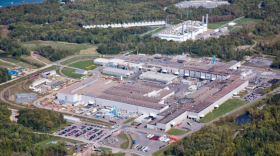This week, Oswego celebrated the small but significant role the city played during World War II. It was the only place in America to serve as a camp for mostly Jewish European refugees during the Holocaust. Many say the legacy of this story is the lesson it can teach, one that's still very relevant today.

The day of festivities began with church bells ringing at precisely 7:30 a.m. to mark the exact time that the train carrying the 982 refugees arrived at Fort Ontario 75 years ago. The surviving refugees who returned to Oswego spent the morning traveling to local cemeteries, where they honored those who had died while living at Fort Ontario.
The refugees alive today were children when they arrived in 1944. They shared stories of what it was like to come to a foreign country.
"We didn't know what to expect," Simon Kalderon said. "The food was good. The white bread was like cake."
Henry Brecher says adjusting to life in America was difficult at times.
"I remember going to the movies every weekend, I think it must have been Saturdays - it was one way of learning English," Brecher said. "We never had any formal language lessons. I, for one, didn't speak a word of English."
Despite their struggles, all of the refugees said some of their fondest memories are the people in Oswego who welcomed them to the community. Residents brought the refugees gifts and invited some into their homes for holidays.
"The local people were extremely helpful and positive, as opposed to the anti-Semitism that we were exposed to in our European experience," said Bruno Kaiser, who was 16 when he arrived in Oswego.

Of all the stories that were shared, this is the one that seems to rise above the rest. At a time when the United States and much of the world refused to harbor refugees, Oswego was one of the few exceptions.
Children of the refugees, like Kalderon's daughter Loryn Blum, say people shouldn't forget about that, which is much more than just history to those who were saved.
"A lot of the other relatives didn't - weren't able to - didn't survive," Blum said. "So, I just feel fortunate that I'm here because he was able to come here."
Blum brought her children to the celebration. She and her father Kalderon say it's important to pass this lesson onto the next generation, especially with what's happening today at the southern border. They say the United State's reluctance to take in refugees from Central and South America who are seeking asylum parallels what was happening 75 years ago.
"Those people are fleeing because they’re not safe – just like my dad and his parents," Blum said. "We should welcome them like they welcomed my family."
Others, like the Consul-General of Israel in New York Ambassador Dani Dayan, said this story also serves as a reminder about the dangers of anti-Semitism, which is on the rise.

"There is one difference between us and our forefathers in Europe in the '30s - we are more experienced than them and we know where this scourge of anti-semitism can bring the human race," Dayan said.
Given the age of the remaining refugees, this is likely the last reunion of its kind in Oswego. It's one of the reasons why local and New York state officials are working overtime to make Fort Ontario and the Safe Haven Holocaust Refugee Shelter Museum a national park. Kevin Hill, president of the Safe Haven Museum, says the lessons this story tells must be preserved.
"We need to learn history so we don't repeat it and by learning this history, we can learn how we need to proceed as a country," Hill said.
For Oswego, a national park would do more than just put the city on the map. It would enshrine a part of Oswego's history that to many of the city's residents is a source of significant pride.
"It's really built into the fabric of what Oswego is," Hill said.
Correction: A previous version of this story misidentified Loryn Blum as Loryn Buln. We apologize for the error.








